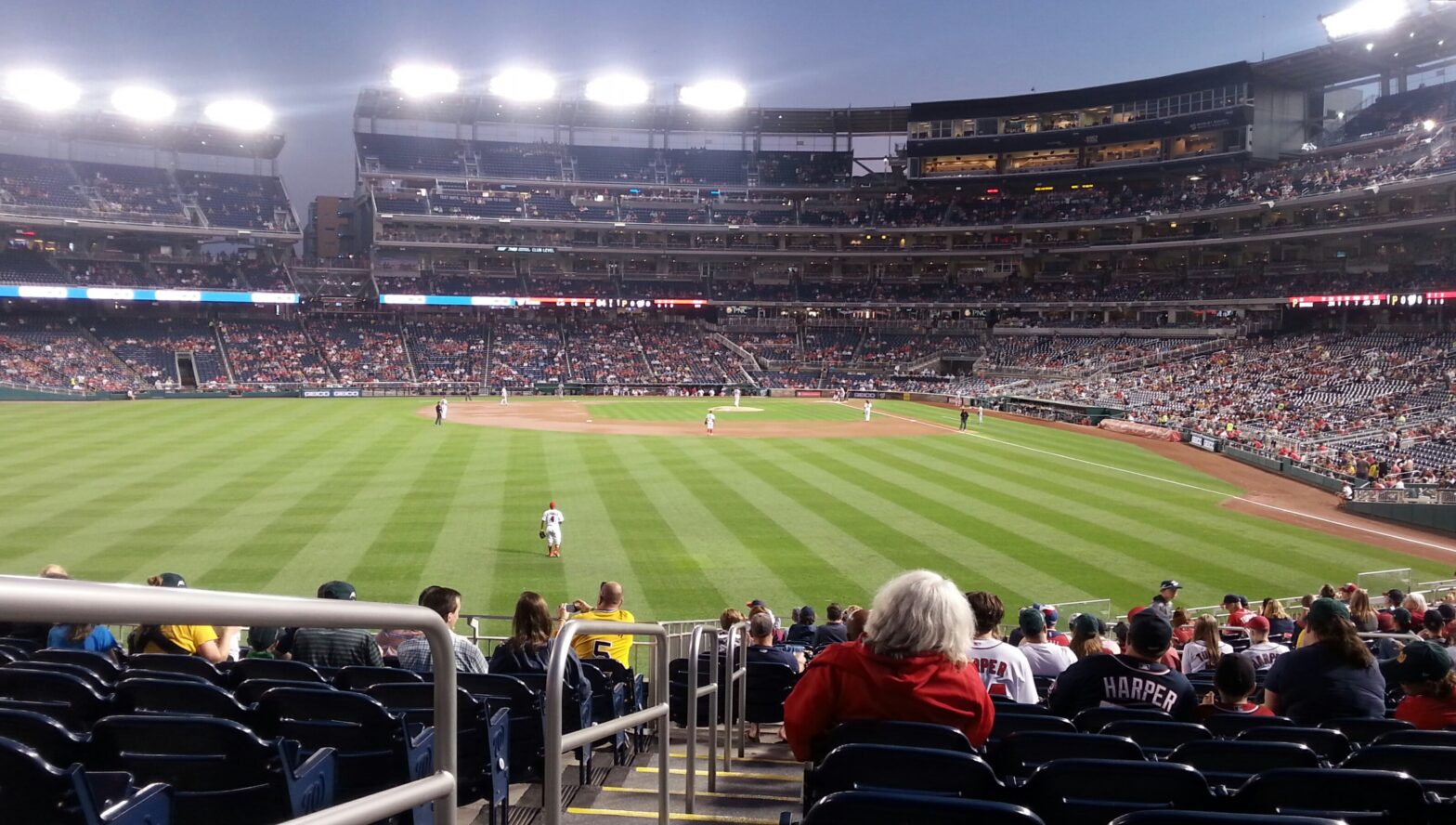Thursday I took a vacation day. I went to Washington, DC for the day.
I hadn’t been in the District since March for Shamrock Fest (though I had been to a baseball game in Bethesda at the beginning of August), and I hadn’t made it to a Nationals game yet this season, and I’d been unable to buy tickets for the National League Division Series between the Nationals and the Cubs (which, all things considered, is fine, as my loyalties are going to be very torn as it is), and it was a good day in my work cycle to go, a day between one set of deadlines just past and another set of deadlines coming up.
Frankly, I couldn’t have asked for a better day. Late September, but very warm and not too hot, like a late June day. The only visual clues that it was September in fact and not June at all were the leaves, some of which were turning, some of which had already fallen, and the shallower angle of the sunlight.
Besides the Nationals game that night, against the Pirates, of whom I’ve long felt a fondness for and, of the demolished classical ballparks, it’s the Pirates’ Forbes Field I’d want to visit the most, I also wanted to visit the Smithsonian — the National Gallery of Art has become quite appealing in my dotage, and I wanted to see the remodeled American History museum — and pay a visit to Congressional Cemetery, quite possibly for the final time, to check a few more family graves and take a few more pictures.
I first visited Congressional Cemetery five years ago. In my genealogical researches, I had discovered that my great-great-grandfather William Gardner was buried there and, after an early Labor Day afternoon Nationals/Cubs game at Nationals Park, I walked from the Navy Yards to the cemetery near RFK Stadium. All I had at the time was a map of the cemetery and the location by the cemetery’s coordinate system and, despite not having any marker, I found the unmarked grave to within about ten feet. I was fairly certain that it was near a tree, but I wasn’t sure. Looking now at the photos I took then, I had it exact, but I didn’t know that then. The following April, another Nationals/Cubs game, this time I was armed with a map I’d drawn myself, marked up with names I’d found in the cemetery’s internment records so I could triangulate a position. William Gardner might not have a headstone, but others did, and I could use the headstones that were there to determine who was where the headstones were not. And so it was that, for the first time in almost certainly decades, a descendant of William Gardner visited his grave and knew that he was there.
Over the years, as my researches advanced, I learned there were others buried there, and I would visit if I had time and reason when I was in DC. William’s sister-in-law (and my great-great-grandmother’s sister) was buried on the other side of the cemetery, near John Philip Sousa. My great-grandfather’s older half-brother, Thomas Hardy, was also buried there, and despite the bitter cold of the day, I stopped to visit his grave (which is also the grave of his wife, daughter, and son-in-law) before Shamrock Fest this year.
Earlier this year, I had a breakthrough. I discovered the married name of William’s oldest daughter Margaret. I knew, from William’s obituary, that he had a daughter living in Washington in 1893, as the funeral was held at her house, but I didn’t know which daughter. There were three possibilities — Margaret, Eleanor (who went by Ella), or Mollie. Ella seemed like the most likely possibility, as I knew that she married and had several children, whereas I had no idea what happened to Margaret and Mollie. For all I knew, Margaret had died sometime after the 1870 Census (the last time she appears as Margaret Gardner) and Mollie after the 1880 Census (the last time she appears as Mollie Gardner).
I looked at William’s obituary one day — I had been talking with my mother and her first cousin after I visited my great-grandfather and great-great-grandmother’s graves at Loudon Park in Baltimore — and something clicked. There was a street address there. It had always been there, it wasn’t a surprise. But I’d never thought to investigate that. I punched it into Google, and suddenly it was as though the world opened up. I had a married name — Margaret Gordon — and I had obituaries with more details. It was all very tenuous at first, but I was soon satisfied that I had found Margaret Gardner. And intriguingly, she was buried very close to her father; only two graves separated them. (Her husband, however, was buried somewhere else.) I had, never knowing it, been at the grave of my great-grandfather’s oldest sister several times.
I decided that, when next I went to Congressional Cemetery, I would visit all the family sites, because there weren’t any more to find. There were some I knew of that I hadn’t looked for, namely Ella and her husband Edward. There were the ones I had learned in the last six months where there. So I downloaded Congressional Cemetery’s list of interments and remade my personal maps (an index card with grids and names). In making those maps, I made another discovery, one tentative at first, and as I researched it, one that became a certainty — I also found Mollie.
I mentioned there were were two graves separating Margaret from her father. One of those sites has a daughter of Ella. Mollie is in the other. In 2013, when I made my first personal map of where William Gardner was buried, I simply didn’t know as much as I know now or how to recognize what I was seeing. Sometimes what seems like insight is really just dumb, blind luck of the pieces falling into place.
My maps made, my plans laid, armed with a cheap selfie stick I could dispose of without guilt, traveling fast and light as though I were hunting Orc, I set out for a day of adventure in the Nation’s Capital.

The front entrance to the cemetery was under construction, and there were mowers clipping the grass throughout the grounds. The buzz of motors was ever-present. There were also some joggers, including a legless man in his thirties in a wheelchair, out with his dogs.
I decided I would start with Ella and Edward Hawk. They were in a part of the cemetery I’d never visited before. I’d looked into it from this intersection, but I’d never gone in for a look.

The cemetery map I’d picked up at the gate wasn’t entirely helpful. There were features, like brick walkways, that weren’t reflected on the map, so I had a difficult time judging where I was. But I had my handwritten index card map of the Hawks’ area, and I soon saw some names that I knew I would find.
And there I saw a small headstone, worn from age. Edw’d Hawke. Co. 1.

Edward Hawk was about twenty years older than Ella. He was a Civil War veteran, having served in a Pennsylvania regiment during the war. He was also a felon; he was convicted of larceny in 1869 and spent three years in the Pennsylvania State Penitentiary in Philadelphia (ie., Eastern State). He died in 1909.
Unmarked, to the left of Edward’s headstone, is Ella and their daughter Ida.

Ella died in 1929. Ida died in 1898; she was five.
They had a number of children, and at least two, Ada and Edward, survived to adulthood. Ada married a man named Charles Wehnert. Edward served in the Navy during World War I, deserted in 1918 when his ship was in New York City, and was court-martialed. I believe Ada has living descendants while Edward does not.
In the same area, about sixty-five feet to the east, is the grave of Walter Gordon, the oldest son of Margaret Gordon.

I know nothing of Walter, except that he was three and a half when his uncle, my great-grandfather Allyn, was born. Allyn was a very late in life child; his father William was already fifty-three or fifty-four when he was born. Margaret, Allyn’s oldest sister, was married and in her late twenties.
This part of the cemetery had fallen into disrepair in the past. There are fallen and broken headstones, and there are wildly different styles. Walter’s flat metal plaque stands out as incongruous among the graves.

I’d visited Thomas Hardy’s grave in March when I was in DC for Shamrock Fest. Thomas was the oldest son of my great-great-grandmother Susan and the half-brother of my great-grandfather Allyn. I believe Thomas served in the Navy for a few years. Thomas is buried with his wife Emma near none other than former DC mayor Marion Barry.

On the opposite side is Thomas and Emma’s daughter Kate and her husband, Milton Norris.
They have living descendants.

Thomas had a brother, Henry Hardy. I’m not certain what happened to Henry. I know he lived in Baltimore for a time with the Gardners when they relocated from Washington to Baltimore circa 1886. Ancestry has suggested possible matches (a Henry Hardy with a wife named Ruth or Helen in various orders), but there’s nothing definitive right now I can point to and say, “Yes, that’s him.”
Up the hill, past J. Edgar Hoover, and to the right is the Gardner family plot. And it is a plot, though I did not know that when first I visited in 2012. Then, I thought there were only three people there — William Gardner, his first wife Mary Elizabeth, and her mother, Anne Atwell. Now I know there are nine.

There, beyond the Kerper and Stenzel headstones, running down to the black Bradley monument, are five spaces, each two graves deep.
Behind the Kerper headstone are Mary Elizabeth and her mother Anne. Mary died in 1868 in her mid-thirties. Anne lived with William Gardner’s family from the 1850s until her death in June 1886. Anne was very old — she was born around 1800 — so my working theory for a number of years has been that the Gardners relocated from Washington to Baltimore after her death; perhaps they had wanted to move, but Anne’s age and frailty made an inter-city move difficult.
Behind the Stenzel headstone is William Gardner. He died in January 1893 of a brain tumor. Born around 1825, he was a tinner by trade and most of his sons followed in his footsteps for a time. (William, Jr., James, Maurice, Arthur, and stepson Henry are all listed as “tinners” in various Washington and Baltimore city directories of the time.) My great-great-grandmother Susan, William’s second wife, is not buried here; she is buried in Baltimore.
To the right of William are George and Mollie Keagle.
Thus far, I know very little of George and Mollie, though I know slightly more of Mollie than I do of George. It wasn’t until last week that I realized they were of any significance at all to my lineage. It was when I realized there were Gardners in these two locations and Gardners in those two locations, and there’s a location in between, it stood to reason that maybe there was a Gardner in the location in the middle, and so I started to investigate.
Mollie was married three times. The first marriage was to a man surnamed Barnard; this marriage ended in divorce by 1893. (A fact I know from Mollie’s marriage record to her second husband.) Not being familiar with the divorce and marriage laws of late 19th-century DC and/or Maryland, I can’t say how difficult it was to get a divorce at the time, and I can’t even begin to speculate as to the reasons or who was at fault. Based on Census information, Mollie likely had four children with her first husband, but I don’t know any of their names or if they were in Baltimore or Washington.
Mollie’s second marriage was to her first cousin, John Hanson. Yes, first cousin. John’s mother was William Gardner’s (half?) sister Elizabeth. They married in February 1893, about a month after William Gardner’s death. They had a daughter named Mollie Estelle in 1894; she died in 1938.
The second marriage did not last long, as Mollie married George Keagle, ten years her junior, circa 1895. They appear not to have children. (Mollie was in her mid-thirties when they married, so further children were certainly possible.) Mollie lived in Baltimore from the 1890s onward to the 1930s, at which point she and George moved to Washington. Mollie died in 1940, George in 1948.
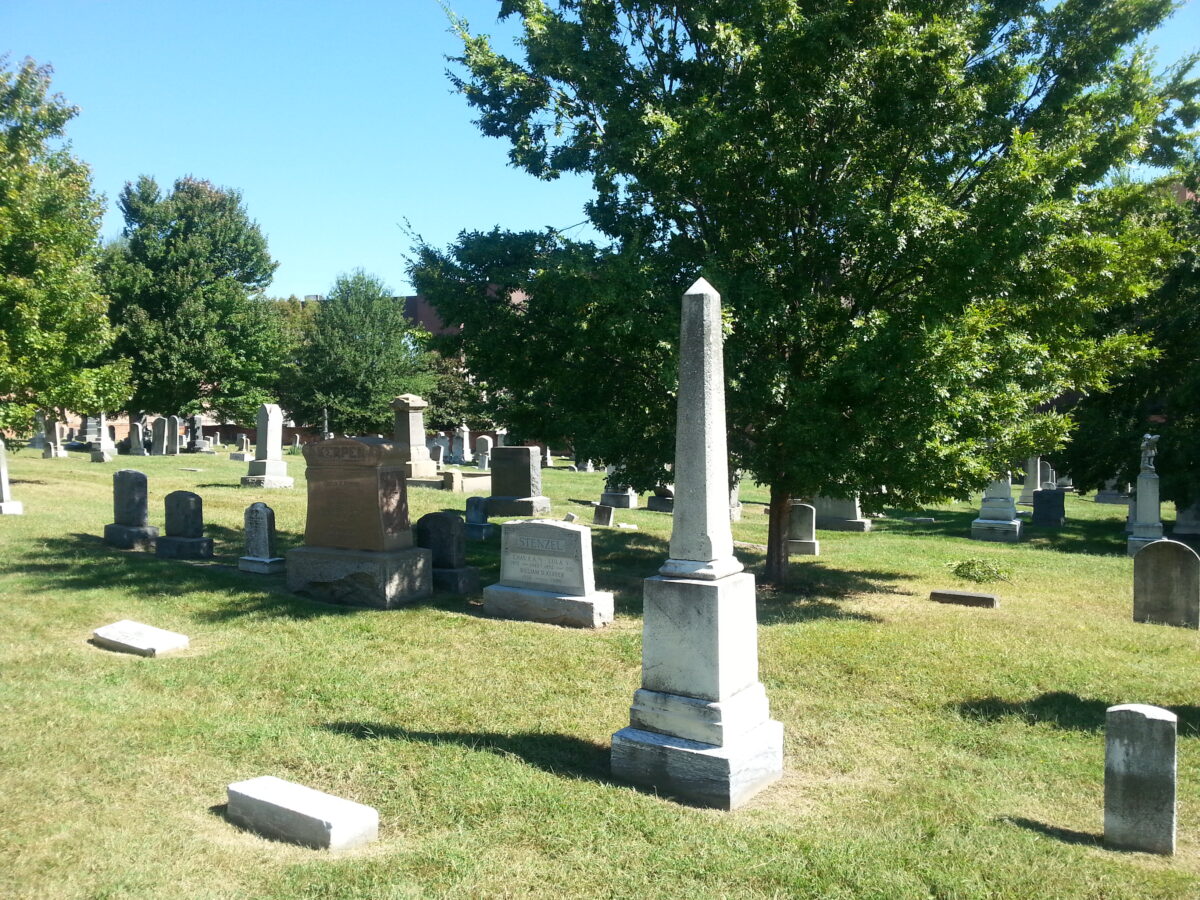
Next to Mollie and George is Mary Elizabeth Hawk, an infant daughter of Ella and Edward. She was born in early 1890 and died on July 25th of that year and apparently named after Ella’s mother.
Also buried there is an absolute mystery to me — Samuel Soper. According to Congressional Cemetery’s records, he was buried there on March 29, 1943. I have no idea who he is. I have no idea of his age.
Finally, in the final graves of the Gardner plot at Congressional Cemetery are Margaret Gordon and one of her children.
Sometime in the early 1870s, probably when Margaret was about sixteen, she married William Gordon, a carpenter. They had children, five of whom reached adulthood. William died in 1887, aged forty, and was buried elsewhere in Congressional Cemetery, not in the Gardner plot.
Margaret lived until 1918. She never remarried, and continued to live in the same home on South Carolina Avenue until the 1910s. (At that point, going off memory here, she moved in with one of her daughters and her youngest son took possession of the house.) The Washington City Directories of the time don’t list an occupation for Margaret. Instead, they list her as a widow. In short, it appears that she was financially secure enough for thirty years to not have to remarry for the financial stability of herself and her children.
Here’s where things get odd. The child that Margaret is buried with, the name is given in Congressional Cemetery’s records as (Child) Gordon, which to me suggests that the child (since I have no idea if it were a boy or a girl) was a nameless infant who died shortly after childbirth. And this is the puzzle — this child died in January 1890, two years and three months after Margaret’s husband William died. Maybe the child did have a name, was several years old, and for whatever reason the name wasn’t written down in the records.
If not, then it’s all very strange.
The map I made for William Gordon’s grave proved to be completely useless. I was unable to match a single name on a headstone to a name on my index card as it appears that William was buried in a vast area of unmarked graves near the eastern section of cenotaphs. (There’s a western section of cenotaphs near the entrance, and an eastern section obviously to the east.) There was simply nothing to orient me.
On the opposite side of the cemetery, near John Philip Sousa and the 9-11 trail is the grave of William and Laura Meldrum. Laura was my great-great-grandmother Susan’s half-sister, and in August I discovered the story of her sad and tragic role in my great-great-grandmother’s death back in 1902.

While the headstone names only William, he and Laura share the spot. I had believed that the other Meldrums here were William and Laura’s children, but upon pouring through obituaries I learned they were William’s parents and sister.
With that, I had seen all of the wider Gardner family that I knew to be there. I doubt there is anyone else to find in Congressional Cemetery. There are (arguably) three of my great-grandfather Allyn’s siblings whose fates remain open-ended to me — William Gardner, Jr., who I know now made the move to Baltimore in 1886 but then disappears from any historical record I’ve seen; Henry Hardy, who I also know was in Baltimore in the late 1880s and early 1890s and then disappears; and James, who I believe is buried in Leesburg, Virginia, because all of the available evidence points in that direction, but the obituary for James Gardner in Leesburg makes no sense.
There was something else I wanted to see in Congressional Cemetery — and the reason I brought a selfie stick.
Philip Pendleton Barbour is buried there.
Barbour served in Congress from 1814 to 1825, and again from 1827 to 1830, with a stint as the Speaker of the House from 1821 to 1823. In 1830, he was appointed a federal circuit judge by Andrew Jackson, and Jackson elevated Barbour to the Supreme Court in 1836, where he served until his death in 1841.
Barbour County, West Virginia, the county’s town seat of Philippi, and the county high school, Philip Barbour High School, are all named for Barbour. And as a graduate of Philip Barbour High School, I wanted to find his grave.
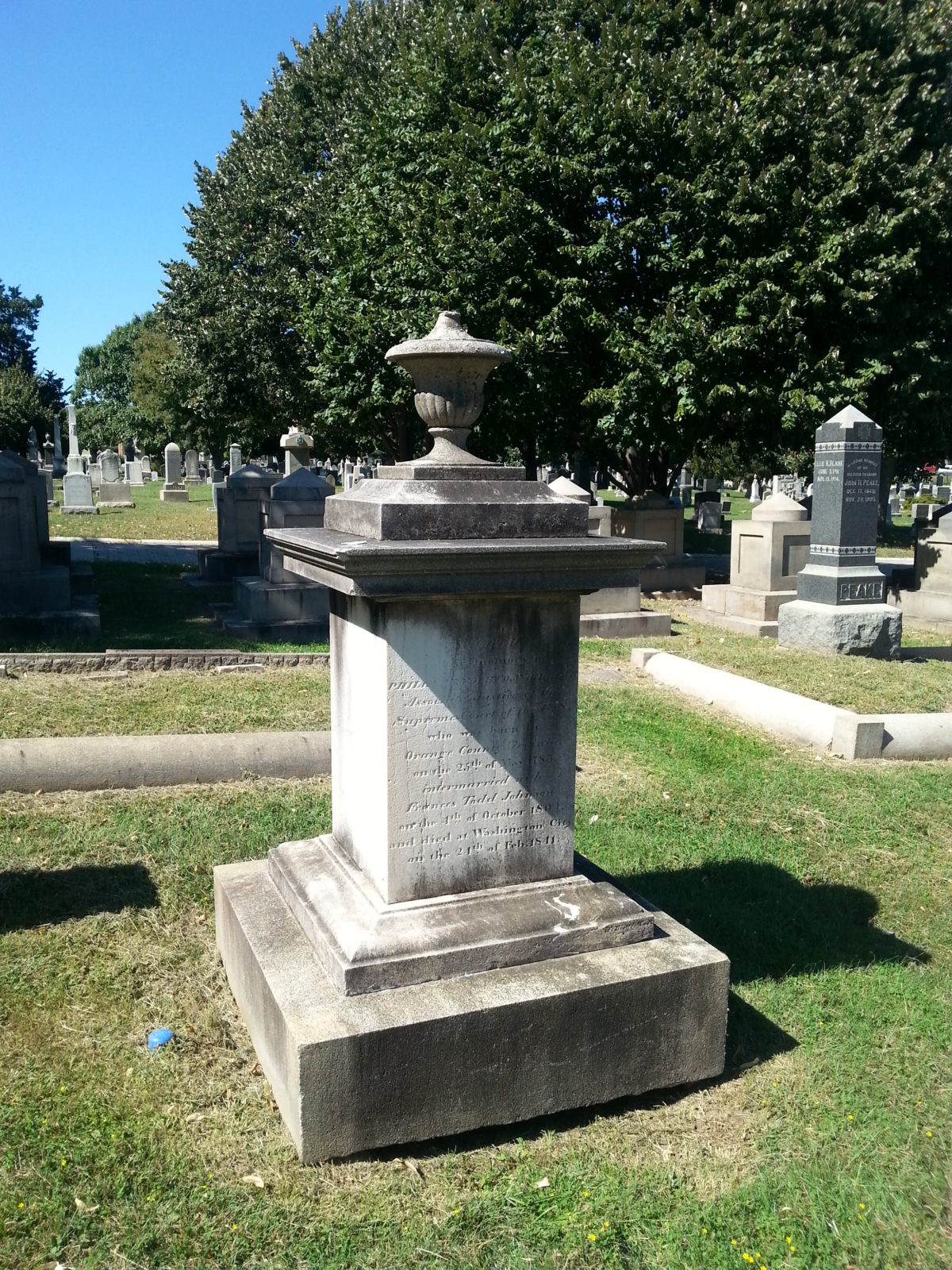
It took some searching. It’s behind the western cenotaphs — and now that I know what it looks like I can see in older pictures of the cenotaphs that I’ve taken its picture before and never realized it. There are more eye-catching monuments there. Barbour’s is understated by comparison.
Obviously, I had to get a picture with Philip Pendleton Barbour. How many Philip Barbour graduates have gone to Congressional Cemetery? How many have gone looking for Philip Barbour himself? The answer to both questions must surely number in the single digits. I wouldn’t be especially surprised if I were the first.
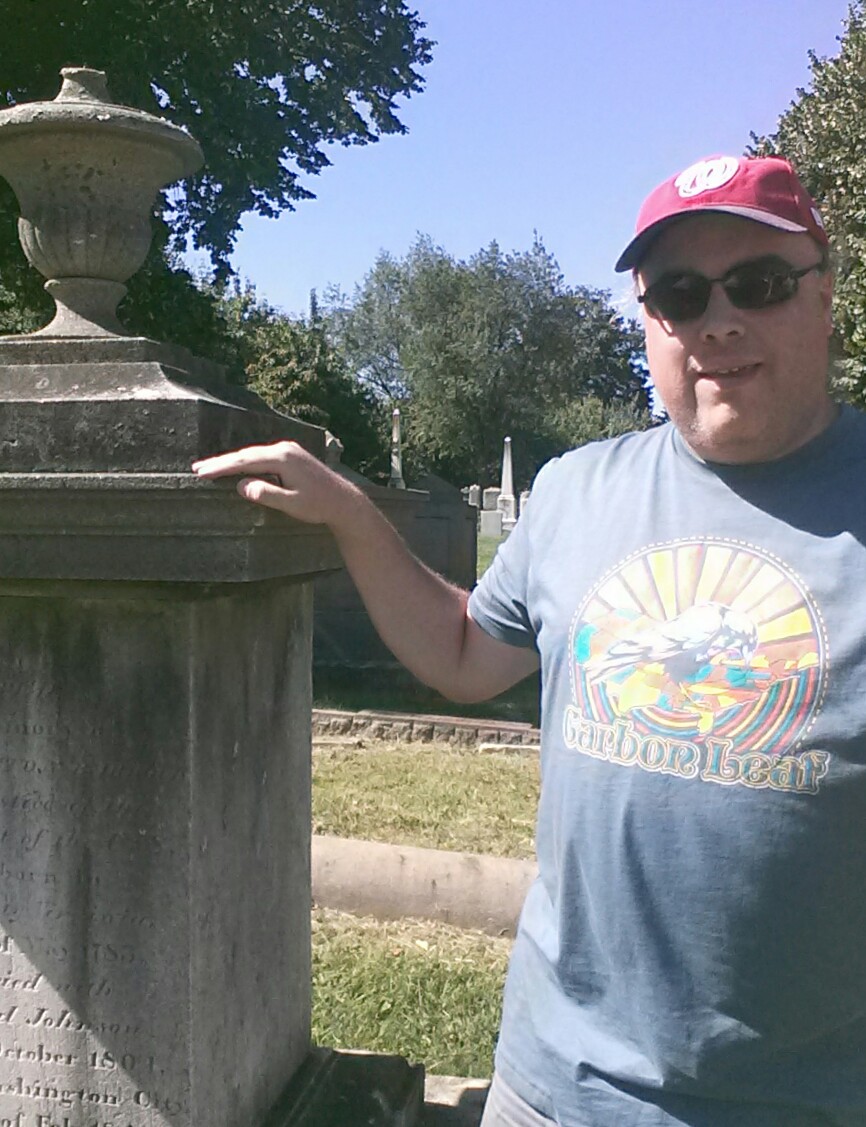
Yes, I was rocking out a Carbon Leaf t-shirt.
I don’t normally wear band t-shirts as I don’t own many and the few I’ve bought have been for purely collector reasons, something I try not to do now as it’s rather pointless. But Carbon Leaf was selling this shirt and some of the proceeds were going to Hurricane Harvey relief, so I made an exception to my “rule.”
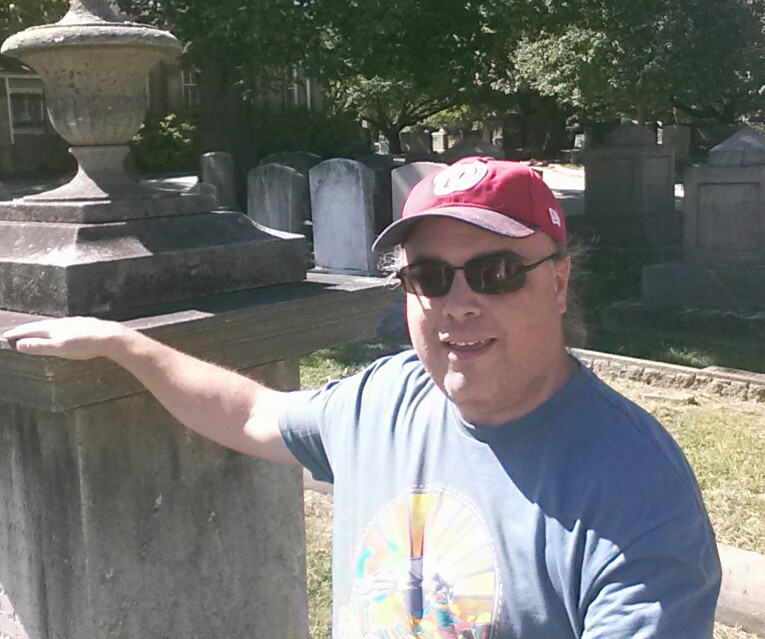
The selfie stick, which I bought at Dollar Tree near the office, survived its one time use, its head snapping off when I removed my smartphone.
Next to the Philip Pendleton Barbour monument is this monument to Commodore John Rodgers and his son, Midshipman Frederick Rodgers, of the United States Navy. It’s a striking piece not just because of the style — it’s obviously a pyramidal structure that stands out, even among the cenotaphs designed by Benjamin Latrobe — but because of the artistry that went into the carving.
The east face bears this inscription: “In memory of Midshipman Frederick Rodgers, drowned near Norfolk Virginia 5th April 1828, aged 17 years & 1 month, making noble efforts to save Midshipmen Slidell & Harrison, his friends & companions in life & in death. This Tomb is raised by his Father. Remarkable from early infancy for filial affection, love of truth, ingeniousness & modesty, the last tragic scene of this lamented youth display a bright example of generous intrepidity, an exalted mixture of the profession, to which his best faculties & ardent aspirations were devoted.”

You’ll find script of this style throughout the cemetery, particularly in some of the older sections that date back to the earliest days of Washington. (The cemetery was opened in 1807.) Typically, this script will be found on darker headstones. Some headstones of this type are extraordinarily thin. Others are six feet long and lay flat on the ground or on raised pillars. I’m not sure what material was used for headstones of this type, but it has weathered the past 180-200 years remarkably well. Near my great-great-grandfather’s site, I tried to read a headstone that wasn’t anywhere near as old, and it was completely unreadable. I don’t know what these headstones were made of or how they were made, but they’re fascinating artifacts.

What particularly struck me about this monument to Commodore Rodgers and his son was how the carving was designed. The face of the monument slopes away from the visitor, yet the letters as you read down remain the same height. Not only are the letters at the top larger than the letters at the bottom, but each letter becomes larger from bottom to top. The visual effect is of letters of a consistent height on the face, but in reality the letters were sketched on an inverted trapezoid and stretch out to the top.
Nearby is the monument to Abel Upshur, Secretary of State and Secretary of the Navy during John Tyler’s administration.

Upshur died in 1844 as a result of the explosion of an artillery gun aboard the USS Princeton.
Upshur is no longer buried there; his remains were removed to Oak Hill Cemetery in the 1870s, but his monument remains. For a time, then, Barbour and Upshur lay within twenty feet of each other at Congressional Cemetery just as, in West Virginia, Barbour County and Upshur County border one another.
One of the most striking memorials in the area belong to Alexander Macomb, the Commanding General of the United States Army in the 1830s and victor at the Battle of Plattsburgh in the War of 1812.

There’s something almost Napoleonic about Macomb’s memorial. It looks like nothing else there — and perhaps like nothing else, period. It stands 13 feet tall, weighs something like 6 tons, towers over everything, and is topped by a sculpture that is utterly distinctive. It’s impossible to miss, that’s for certain.
After exploring Congressional Cemetery, I went for lunch at La Lomita, a Mexican restaurant at the corner of Pennsylvania and G Streets SE. I’d been there before — my first time visiting Congressional Cemetery, as a matter of fact — but not in several years.

For lunch I had a beef burrito. It was pricey — lunch at La Lomita cost double what lunch at La Tolteca near the office would — but it was also very, very good.

Apparently the area around La Lomita is going to be redeveloped and condos put up.
There’s really nothing to say about the Smithsonian. I remain impressed with my ability to navigate the L’Enfant Plaza Metro Station like a native Washingtonian. (Ron Howard Voice: “Allyn is not a native.”)
The new grass on the National Mall looks fantastic.
I sat on a bench opposite the Smithsonian castle and watched the world pass by for a little bit. A festival was setting up, there were some guys playing frisbee, people rode by on bike-share bikes, joggers passed.
I went to the Navy Archives Metro Station and milled about the Navy Memorial for a little while. It’s a quiet place with fountains, a good place for reflection, and I love the bas reliefs of various Navy functions. Then about five I hopped on the Green Line and went down to the Navy Yards for the ballgame.

There’s not a great deal to say about the game, either. It was a meaningless late season game — the Nationals were assured of home field advantage agains the Cubs in the NLDS, the Pirates had been eliminated — and Dusty Baker ran out what was essentially a spring training line-up. I left after the sixth inning, not something I’d have ordinarily done, but it was already 9:30, the game was meaningless, and it would take at least two and a half hours to get home.
As it was, I heard the bottom of the ninth inning, in which the Nationals walked off with a victory, on the radio once I reached the Beetle in the parking lot of the Greenbelt Metro Station.
The drive back to York was uneventful.
I’d say I had a good day. 🙂
